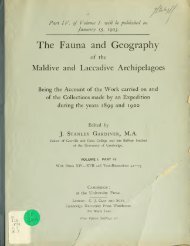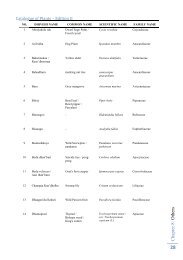Download - WordPress – www.wordpress.com
Download - WordPress – www.wordpress.com
Download - WordPress – www.wordpress.com
Create successful ePaper yourself
Turn your PDF publications into a flip-book with our unique Google optimized e-Paper software.
THE ENTEROPNEUSTA. 663gro\vth of the animal. This latter condition precludes the direct use of absolute measurements.It is obvious that a ratio must be made use of—a simple ratio whose two factors areequally affected by growth changes. Though several distinct regions may be distinguishedin the body of a Ptychodera, with the exception of the collar and branchial region, theirlimits are not very clearly defined. Accordingly most attention has been paid to the ratioof branchial to collar length. And this more especially since any collection of Enteropneustswill be largely made up of damaged specimens, and though few specimens may attain toanything like <strong>com</strong>pleteness, yet in the gi-eat majority both collar and branchial regions willbe perfect. Great accuracy in the measurement of such animals as the Enteropneusta isout of the question since in a soft-bodied creature relative differences in the state ofcontraction of the various body regions may easily occur, whilst the personal equation mustenter largely into the result. In the present instance however all the material had beentreated in the same way, i.e. had been nai'cotised in chloral hydrate for several hours beforepreservation, thus ensuring an equable contraction, whilst the personal equation was as faras possible eliminated by my making all the measurements within the space of a week or so.By i-AV the most frequent of the varieties described in this paper is laccadivensis, andit is here that the measurements are most <strong>com</strong>plete. In addition to the length of thecollar and of the branchial region the total length and the length of the genito-hepaticregions was measured wherever the specimen was sufficiently perfect. The width of thecollar was also registered. The results for 123 specimens (fewer in the case of the genitohepaticand total lengths) are given in Table 11, pp. 671— 2, and in the diagram on p. 666.Before however anj- value can be attached to these figures it must be shewn how, if atall, growth affects these ratios.The method employed for estimating growth changes was to divide the animals intoseveral groups according to size, and to calculate the above three ratios for each groupseparately. As the collar width was sometimes less, sometimes greater, than the length itwas thought advisable to take this factor also into account, and in the case of laccadivensisthe following groups were made.Group 1. Collar length x breadth not > 16„ 2. „ „ X „ > 16, but not > 25.„ 3. „ „ X „ >25, „ „ >36.„ 4. „ „ X „ >36






